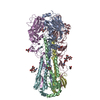[English] 日本語
 Yorodumi
Yorodumi- EMDB-46824: Polyclonal immune complex of human subject 321-2006 Fab binding H1 HA -
+ Open data
Open data
- Basic information
Basic information
| Entry |  | |||||||||
|---|---|---|---|---|---|---|---|---|---|---|
| Title | Polyclonal immune complex of human subject 321-2006 Fab binding H1 HA | |||||||||
 Map data Map data | Negative stain map of global refinement of particle stack used to sort polyclonal responses to H1 HA from human subject 321-2006 | |||||||||
 Sample Sample |
| |||||||||
 Keywords Keywords | influenza / hemagglutinin / H1 / polyclonal / complex / Fab complex / viral fusion protein / VIRAL PROTEIN | |||||||||
| Biological species |  Homo sapiens (human) Homo sapiens (human) | |||||||||
| Method | single particle reconstruction / negative staining / Resolution: 20.0 Å | |||||||||
 Authors Authors | Han J / Rodriguez AJ / Ferguson JA / Ward AB | |||||||||
| Funding support |  United States, 1 items United States, 1 items
| |||||||||
 Citation Citation |  Journal: bioRxiv / Year: 2025 Journal: bioRxiv / Year: 2025Title: Functional, Immunogenetic, and Structural Convergence in Influenza Immunity between Humans and Macaques. Authors: Maya Sangesland / Ning Li / Yaroslav Tsybovsky / Megan D Rodgers / Julianna Han / Alesandra J Rodriguez / James A Ferguson / Amy R Henry / Sarah C Smith / Jesmine Roberts-Torres / Rebecca A ...Authors: Maya Sangesland / Ning Li / Yaroslav Tsybovsky / Megan D Rodgers / Julianna Han / Alesandra J Rodriguez / James A Ferguson / Amy R Henry / Sarah C Smith / Jesmine Roberts-Torres / Rebecca A Gillespie / Cuiping Liu / Jonah S Merriam / Tyler Stephens / Connor Williams / Emma Maestle / Martin Corcoran / Michelle Ravichandran / Adrian Creanga / Sarah F Andrews / Theodore C Pierson / Gunilla B Karlsson Hedestam / Chaim A Schramm / Douglas S Reed / Daniel C Douek / Tongqing Zhou / Andrew B Ward / Masaru Kanekiyo /   Abstract: Human B cell immunity to the influenza hemagglutinin (HA) stem region, a universal influenza vaccine target, is often stereotyped and immunogenetically restricted, posing challenges for study outside ...Human B cell immunity to the influenza hemagglutinin (HA) stem region, a universal influenza vaccine target, is often stereotyped and immunogenetically restricted, posing challenges for study outside humans. Here, we show that macaques vaccinated with a HA stem immunogen elicit human-like public B cell lineages targeting two major conserved sites of vulnerability, the central stem and anchor epitopes. Central stem antibodies were predominantly derived from V1-138, the macaque homolog of human V1-69, a V-gene preferentially used in human central stem broadly neutralizing antibodies (bnAbs). Similarly, macaques produced anchor bnAbs with the human-like NWP motif. Both bnAb lineages were functionally and structurally analogous to their human counterparts, with recognition mediated largely by germline-encoded motifs. Thus the macaque immunoglobulin repertoire supports human-like public bnAb responses to influenza HA. Moreover, this underscores the utility of homologous germline-encoded immunity, suggesting that immune repertoires of macaques and humans may have been similarly shaped during evolution. | |||||||||
| History |
|
- Structure visualization
Structure visualization
| Supplemental images |
|---|
- Downloads & links
Downloads & links
-EMDB archive
| Map data |  emd_46824.map.gz emd_46824.map.gz | 26.4 MB |  EMDB map data format EMDB map data format | |
|---|---|---|---|---|
| Header (meta data) |  emd-46824-v30.xml emd-46824-v30.xml emd-46824.xml emd-46824.xml | 22.5 KB 22.5 KB | Display Display |  EMDB header EMDB header |
| Images |  emd_46824.png emd_46824.png | 33.6 KB | ||
| Filedesc metadata |  emd-46824.cif.gz emd-46824.cif.gz | 4.6 KB | ||
| Others |  emd_46824_additional_1.map.gz emd_46824_additional_1.map.gz emd_46824_additional_2.map.gz emd_46824_additional_2.map.gz emd_46824_additional_3.map.gz emd_46824_additional_3.map.gz emd_46824_half_map_1.map.gz emd_46824_half_map_1.map.gz emd_46824_half_map_2.map.gz emd_46824_half_map_2.map.gz | 26.4 MB 26.4 MB 26.4 MB 26.4 MB 26.4 MB | ||
| Archive directory |  http://ftp.pdbj.org/pub/emdb/structures/EMD-46824 http://ftp.pdbj.org/pub/emdb/structures/EMD-46824 ftp://ftp.pdbj.org/pub/emdb/structures/EMD-46824 ftp://ftp.pdbj.org/pub/emdb/structures/EMD-46824 | HTTPS FTP |
-Validation report
| Summary document |  emd_46824_validation.pdf.gz emd_46824_validation.pdf.gz | 576.2 KB | Display |  EMDB validaton report EMDB validaton report |
|---|---|---|---|---|
| Full document |  emd_46824_full_validation.pdf.gz emd_46824_full_validation.pdf.gz | 575.9 KB | Display | |
| Data in XML |  emd_46824_validation.xml.gz emd_46824_validation.xml.gz | 10.9 KB | Display | |
| Data in CIF |  emd_46824_validation.cif.gz emd_46824_validation.cif.gz | 13 KB | Display | |
| Arichive directory |  https://ftp.pdbj.org/pub/emdb/validation_reports/EMD-46824 https://ftp.pdbj.org/pub/emdb/validation_reports/EMD-46824 ftp://ftp.pdbj.org/pub/emdb/validation_reports/EMD-46824 ftp://ftp.pdbj.org/pub/emdb/validation_reports/EMD-46824 | HTTPS FTP |
-Related structure data
- Links
Links
| EMDB pages |  EMDB (EBI/PDBe) / EMDB (EBI/PDBe) /  EMDataResource EMDataResource |
|---|
- Map
Map
| File |  Download / File: emd_46824.map.gz / Format: CCP4 / Size: 34.3 MB / Type: IMAGE STORED AS FLOATING POINT NUMBER (4 BYTES) Download / File: emd_46824.map.gz / Format: CCP4 / Size: 34.3 MB / Type: IMAGE STORED AS FLOATING POINT NUMBER (4 BYTES) | ||||||||||||||||||||||||||||||||||||
|---|---|---|---|---|---|---|---|---|---|---|---|---|---|---|---|---|---|---|---|---|---|---|---|---|---|---|---|---|---|---|---|---|---|---|---|---|---|
| Annotation | Negative stain map of global refinement of particle stack used to sort polyclonal responses to H1 HA from human subject 321-2006 | ||||||||||||||||||||||||||||||||||||
| Projections & slices | Image control
Images are generated by Spider. | ||||||||||||||||||||||||||||||||||||
| Voxel size | X=Y=Z: 2.06 Å | ||||||||||||||||||||||||||||||||||||
| Density |
| ||||||||||||||||||||||||||||||||||||
| Symmetry | Space group: 1 | ||||||||||||||||||||||||||||||||||||
| Details | EMDB XML:
|
-Supplemental data
-Additional map: Negative stain map of polyclonal Fab binding the...
| File | emd_46824_additional_1.map | ||||||||||||
|---|---|---|---|---|---|---|---|---|---|---|---|---|---|
| Annotation | Negative stain map of polyclonal Fab binding the H1 HA low stem epitope from human subject 321-2006 | ||||||||||||
| Projections & Slices |
| ||||||||||||
| Density Histograms |
-Additional map: Negative stain map of polyclonal Fab binding the...
| File | emd_46824_additional_2.map | ||||||||||||
|---|---|---|---|---|---|---|---|---|---|---|---|---|---|
| Annotation | Negative stain map of polyclonal Fab binding the H1 HA central stem epitope from human subject 321-2006 | ||||||||||||
| Projections & Slices |
| ||||||||||||
| Density Histograms |
-Additional map: Negative stain map of polyclonal Fab binding the...
| File | emd_46824_additional_3.map | ||||||||||||
|---|---|---|---|---|---|---|---|---|---|---|---|---|---|
| Annotation | Negative stain map of polyclonal Fab binding the H1 HA anchor epitope from human subject 321-2006 | ||||||||||||
| Projections & Slices |
| ||||||||||||
| Density Histograms |
-Half map: Negative stain half map B for global refinement...
| File | emd_46824_half_map_1.map | ||||||||||||
|---|---|---|---|---|---|---|---|---|---|---|---|---|---|
| Annotation | Negative stain half map B for global refinement of particle stack used to sort polyclonal responses to H1 HA from human subject 321-2006 | ||||||||||||
| Projections & Slices |
| ||||||||||||
| Density Histograms |
-Half map: Negative stain half map A for global refinement...
| File | emd_46824_half_map_2.map | ||||||||||||
|---|---|---|---|---|---|---|---|---|---|---|---|---|---|
| Annotation | Negative stain half map A for global refinement of particle stack used to sort polyclonal responses to H1 HA from human subject 321-2006 | ||||||||||||
| Projections & Slices |
| ||||||||||||
| Density Histograms |
- Sample components
Sample components
-Entire : Polyclonal immune complex of human subject 321-2006 Fab binding H1 HA
| Entire | Name: Polyclonal immune complex of human subject 321-2006 Fab binding H1 HA |
|---|---|
| Components |
|
-Supramolecule #1: Polyclonal immune complex of human subject 321-2006 Fab binding H1 HA
| Supramolecule | Name: Polyclonal immune complex of human subject 321-2006 Fab binding H1 HA type: complex / ID: 1 / Parent: 0 |
|---|---|
| Source (natural) | Organism:  Homo sapiens (human) Homo sapiens (human) |
| Molecular weight | Theoretical: 280 KDa |
-Experimental details
-Structure determination
| Method | negative staining |
|---|---|
 Processing Processing | single particle reconstruction |
| Aggregation state | particle |
- Sample preparation
Sample preparation
| Concentration | 0.015 mg/mL |
|---|---|
| Buffer | pH: 7.4 |
| Staining | Type: NEGATIVE / Material: 2% w/v uranyl formate |
| Grid | Model: Homemade / Material: COPPER / Mesh: 400 / Support film - Material: CARBON / Pretreatment - Type: GLOW DISCHARGE |
- Electron microscopy
Electron microscopy
| Microscope | FEI TECNAI SPIRIT |
|---|---|
| Image recording | Film or detector model: FEI EAGLE (4k x 4k) / Average electron dose: 25.0 e/Å2 |
| Electron beam | Acceleration voltage: 200 kV / Electron source: LAB6 |
| Electron optics | Illumination mode: FLOOD BEAM / Imaging mode: DARK FIELD / Nominal defocus max: 2.0 µm / Nominal defocus min: 0.5 µm |
| Sample stage | Specimen holder model: SIDE ENTRY, EUCENTRIC / Cooling holder cryogen: NITROGEN |
| Experimental equipment |  Model: Tecnai Spirit / Image courtesy: FEI Company |
 Movie
Movie Controller
Controller













 Z (Sec.)
Z (Sec.) Y (Row.)
Y (Row.) X (Col.)
X (Col.)





























































